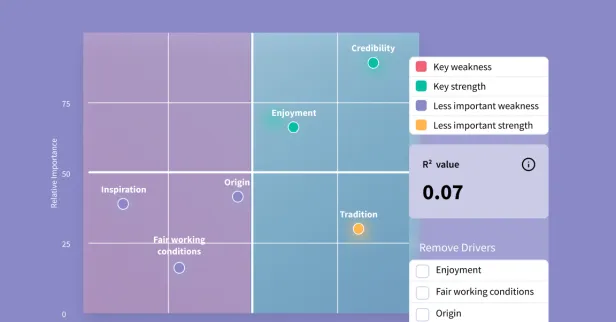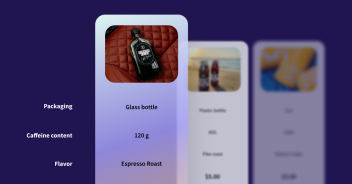We asked a representative sample across generations —Gen Z, Millennials, Gen X, and Boomer— to tell us what gives them the “ick”, what makes them say “wow!”, and what leaves them feeling “meh.” The results reveal a striking mix of shared expectations and generational divides that define how people judge brands in 2025.
1. Everyone Still Buys on the Basics
Across every generation, price and quality were the top two drivers of brand choice, outranking trendiness, social impact, or even customer experience by wide margins.
- 72% said price influences their brand choices most.
- 68% said product quality is the deciding factor.
Even in an era of personalization and purpose-driven messaging, value still rules the day.
Translation: Fancy storytelling won’t save you if your price or product feels off.
2. The "Ick" Factor: Bad Service Tops the List
Bad service was the #1 reason people get turned off by a brand — cited by over two-thirds (67%) of respondents. After that, generational “ick” triggers diverged:
- Gen Z: Cheap packaging (54%) and copycat branding (48%)
- Millennials: Greenwashing (57%), cheap packaging (49%), slow service (45%)
- Gen X: Bad ethics (59%) and slow service (42%)
- Boomers: Political statements (61%) and slow service (47%)
Each group’s “ick” reflects what they value most: originality for Gen Z, authenticity for Millennials, ethics for Gen X, and neutrality for Boomers.
Translation: “Ick” moments happen when brands violate a generation’s core value.
3. Why People Walk Away
When asked why they stopped buying from a brand, price and quality were the clear dealbreakers:
- Rising prices: the top reason for Gen Z (44%), Gen X (47%), and Boomers (52%)
- Declining quality: the leading reason for Millennials (49%)
That tension reveals a split: younger and older consumers are cost-conscious, while Millennials, a generation defined by brand loyalty, are most likely to walk when quality slips.
4. Recovery Looks Different by Generation
When brands make mistakes, everyone wants accountability. But how they want it differs:
- Gen Z (39%) want brands to partner with credible third parties to show change.
- Millennials (42%) want to see brands listen and incorporate feedback.
- Gen X (48%) want brands to correct mistakes quickly and transparently.
- Boomers (51%) want brands to take clear accountability without excuses.
It’s a masterclass in generational communication styles: Gen Z looks for credibility, Millennials for dialogue, Gen X for speed, and Boomers for ownership.
5. The "Wow" Factor: Simple, Human, Honest
When it comes to delight, human moments still win. While value remains the baseline expectation for most consumers (61% cited great value for the price), the true “wow” triggers were far more human:
- Friendly, helpful service (57%)
- Brands that go above and beyond (44%)
Generationally, the “wow” factor looks like this:
- Gen Z: Great value for the price (63%)
- Millennials: Going above and beyond to help a customer (49%)
- Gen X and Boomers: Fast, friendly, human service (58% and 61%, respectively)
The biggest “wow” driver across all groups? A genuinely great customer experience; one that is authentic, efficient, and emotionally resonant.
Translation: Consumers don’t want perfection; they want clarity, care, and responsiveness.
6. The "Meh" Zone: When Brands Feel Forgettable
If “ick” repels and “wow” inspires, “meh” simply numbs. Across generations, mediocrity was the main culprit:
- 52% said “the quality is just okay.”
- 41% said “the brand just isn’t for me.”
- 38% said “it overpromises and underdelivers.”
“Meh” isn’t about dislike, but about disconnection. It’s what happens when brands do everything “fine” but nothing memorable.
7. The Generational Pulse
A few final tensions round out the picture:
- Gen Z and Gen X are largely indifferent when brands take political or social stances (43% and 47% say “I don’t care either way”).
- Millennials (54%) are more supportive of brand activism.
- Boomers (62%) prefer brands to stay out of politics entirely.
As for personalization, nearly half of Boomers (49%) and 42% of Millennials said it crosses the line from helpful to “creepy” when it feels like surveillance, or when ads seem to “listen” or data feels harvested without consent.
Gen Z and Gen X, by comparison, were more evenly split: about a quarter of each group cited creepiness when personalization uses information they didn’t knowingly provide or when ads follow them across devices.
In short, personalization delights when it feels intuitive, but repels when it feels intrusive, especially for older generations who expect clearer boundaries.
8. From Indifference to Impact
Across all the data, one truth stands out: Consumers reward clarity, humanity, and consistency, and they punish tone-deafness, manipulation, or mediocrity.
If bad service gives the “ick” and honest communication earns the “wow,” then the “meh” middle is where brands quietly lose the battle for attention.


